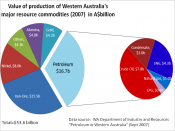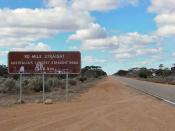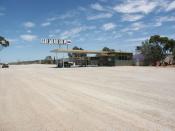Location -
Australia is the smallest of seven continents and the sixth largest country. Because it lies in the Southern Hemisphere, its seasons are the opposite of those in the northern half of the globe. Australia is located between the South Pacific Ocean and the Indian Ocean. It is made up of two islands. Australia is very close to other island nations. To the north are; Papa New Guinea, Indonesia and part of Malaysia. Further to the north are the Philippines and Asian mainland. Southeast of Australia is New Zealand. Like Australia, it was once a British colony. Finally, to the south is the icy continent of Antarctica.
Climate -
Almost half of Australia-the northern part of the county lies in the earth's tropical zone. Australia's tropical region is warm to hot all year. The wet season is November through April and the dry season is May to October.
The southern part of the country has a temperate climate. It has four distinct seasons. Australia's heaviest rains fall along the north, east and southeast coasts. Queensland's coast receives almost 150 inches of rain a year. The wet season brings violent rainstorms and cyclones on the north coast and floods farther inland. Droughts are common throughout much of Australia and can be devastating to the nation's economy. Crops shrivel and die leaving little for the cattle to eat. Snowfall is rare throughout Australia except in the Australian Alps and parts of Tasmania.
Average temperatures in July and January.
July January
Sydney 78 F 61 F
Canberra 82 F 52 F
Darwin 90 F 87 F
Size -
Australia is almost three million square miles. (2,978,147 miles square) It is
approximately 2,500 miles from east to west and 2,300 miles from north to south.
Australia compared to The United States
Australia compared to Japan
Australia compared to The United Kingdom
Australia compared to Europe
Fun Facts -
*Australia produces 95 percent of the world's precious opals and 99 percent of black opals.
*Coober Pedy in South Australia is known as the opal capital of the world. Its population is made up of more than 40 nationalities and, with year-round extremes in temperature, more than 50 per cent of the population live in belowground 'dugouts'.
*Kalgoorlie in Western Australia is not only Australia's largest producer of gold, but has the world's largest political electorate - covering a mammoth 2.2 million square kilometers.
*The kangaroo is unique to Australia and one of our most easily recognized mammals. There are more kangaroos in Australia now than when Australia was first settled. Estimates suggest around 40 million.
*Australia's 140 million sheep (mostly merinos), found on around 53,000 properties, produce more than 70 per cent of the world's wool.
*With 24 million head of cattle, Australia is the world's largest exporter of beef.
*Australia supports at least 25,000 species of plants, while Europe only supports 17,500.
*The longest stretch of straight railway track in the world crosses the Nullarbor Plain. From Nurina in Western Australia to near Watson in South Australia, the track is dead straight for 478 kilometers.
*The Eyre Highway at Caiguna in Western Australia has the longest stretch of straight road in Australia - 148 kilometers. Crossing the southern edge of the Nullarbor Plain, it is the only sealed road from Perth to Adelaide, a 2700-kilometer drive.
*The world's longest continuous fence known as the 'dingo fence', runs through central Queensland for 5,531 kilometers. It is 1.8 meters high and is designed to keep sheep safe from Australia's native dog.
Culture, Population Distribution, and Languages -
In 2001, there were 18.8 million people living in Australia. Of these people, two-thirds were located in Major Cities. The rest were counted mainly in Inner and Outer Regional areas (31%), with only 3% of people counted in either Remote or Very Remote areas. The proportion of the population counted in each of the Remoteness Areas varied considerably across the states and territories. In 2001, almost all of the population of the Australian Capital Territory (99.8%) was located in a Major City, while the Northern Territory had higher proportions of people in Remote (22%) and Very Remote (25%) areas than any other state or territory.
Australia is a multicultural society. Until WWII, Australians were predominantly of Anglo-Celtic descent, but that has changed dramatically. A large number of immigrants from Greece, Italy, Yugoslavia, Lebanon and Turkey came after the war and these have been supplemented by more recent influxes of immigrants from Asia. There are also about 380,000 Aborigines and Torres Strait Islanders. Consequently, many Australians speak Italian, Greek, Lebanese, Vietnamese or Arabic as their first language.
History -
Australia's original inhabitants, known as Australian Aborigines, have the longest continuous cultural history in the world, with origins dating back to the last Ice age. Although mystery and debate shroud many aspects of Australian prehistory, it is generally accepted that the first humans traveled across the sea from Indonesia about 70,000 years ago. The first visitors, called 'Robust' by archaeologists because of their heavy-boned physique, were followed 20,000 years later by the more slender 'Gracile' people, the ancestors of Australian Aborigines.
Europeans began to encroach on Australia in the 16th century: Portuguese navigators were followed by Dutch explorers and the enterprising English pirate William Dampier. Captain James Cook sailed the entire length of the eastern coast in 1770, stopping at Botany Bay on the way. After rounding Cape York, he claimed the continent for the British and named it New South Wales.
In 1779, Joseph Banks (a naturalist on Cook's voyage) suggested that Britain could solve overcrowding problems in its prisons by transporting convicts to New South Wales. In 1787, the First Fleet set sail for Botany Bay under the command of Captain Arthur Philip, who was to become the colony's first governor. The fleet comprised 11 ships, 750 male and female convicts, four companies of marines and supplies for two years. Philip arrived in Botany Bay on 26 January 1788, but soon moved north to Sydney Cove, where there was better land and water. For the new arrivals, New South Wales was a harsh and horrible place, and the threat of starvation hung over the colony for at least 16 years.
Free settlers began to be attracted to Australia over the next decades, but it was the discovery of gold in the 1850s that changed the face of the colony. The huge influx of migrants and several large finds boosted the economy and irrevocably changed the colonial social structures. Aborigines were ruthlessly pushed off their tribal lands as new settlers took up land for farming or mining. The Industrial Revolution in England required plenty of raw materials, and Australia's agricultural and mineral resources expanded to meet the demand.
Australia became a nation when federation of the separate colonies took place on 1 January 1901 (although many of the legal and cultural ties with England remained). Australian troops fought alongside the British in the Boer War, WWI and WWII. However, the USA's role in protecting Australia from Japanese invasion during WWII marked the beginning of a shift in allegiance. Australia subsequently followed the USA into both the Korean and Vietnam wars in Asia.
Post WWII immigration brought a flood of European immigrants, many of them non-British. The immigrants have since made an enormous contribution to the country, enlivening its culture and broadening its vision. The post-war era was a boom time in Australia as its raw materials were once again in great demand. In the 1980s, Australia accepted large numbers of Asian refugees, especially from Vietnam. Socially and economically, Australia is still trying to come to terms with its place in Asia. Issues of the day include republicanism, universal acceptance of the Native Title Act passed in 1993, policies regarding refugees and a push for an official government apology for the injustices suffered by the stolen generation of Aborigines. Unfortunately, many Aborigines continue to live in deplorable conditions.
Economics -
Australia enjoys one of the world's healthiest economies and highest standards of living but an economic recession struck in the late 1980's and early 1990's. Businesses across the country suffered and many companies laid off workers or closed down completely. As jobs became scarce, the recession revived the question of immigration. The 1990's also brought drought along with wildfires in the forests and ranges. Millions of acres of grazing land were destroyed. In 1993, Aboriginals won the right to make claims to tribal land taken from them since 1788. Opposition has been fierce, as framers and miners feared loss of their land. Since the Native Title Act, Aboriginals have made many successful claims. Usually agreements allow farmers and natives to share land. Sydney Australia was chosen for the 2000 Summer Olympics. The games brought billions of dollars.
Government -
The government of Australia is similar to that of The United States. Governing power is divided between the federal government and the state governments. There is also a balance of powers among the three branches of government-executive, legislative, and judicial. Politically, Australia is divided into six states and two mainland territories. Each unit has a governor, a premier, and a parliament. The governor represents the British monarch. The head of each government in a state or territory is the premier, or chief minister. Australia's local governments are shires and cities or towns. Most are governed by elected councils. By law, Australian citizens over 18 must vote. Voters use a preferential system. In this system voters number their choice in order and even losing candidates have a voice in the government.
Sports -
Australians start playing team sports in elementary school. Every town has amateur sports teams and fans crowd the stadiums to cheer their favorite professionals. Cricket, a ball and bat game, was traditionally a popular pastime for British upper class. Settlers brought cricket to Australia, where it is now the most popular summertime sport.
Rugby, another British sport, is a cross between soccer and American football. Ruby league is the professional form, while the rugby union is the amateur version. Rugby league is very popular in Queensland and New South Wales. Another kind of football game is association football, or soccer. Australia's rugby and soccer teams compete all over the world.
Australian Rules Football is uniquely Australian. The first game took place in Melbourne in 1858. The Grand Final, like the Super Bowl in The United States, is one of the biggest sporting events of the year.
Australia's warm climate makes a good setting for golf, tennis, and track. Dozens of Australian's have brought back medals from the Olympic Games. The country's sunny and sandy beaches are great for swimming, surfing, boating, and yachting. Sydney's Bondi Beach is the most famous beach in Australia. It is packed with surfers and sunbathers. Surfboat races are major events in Australia. The crews row out to markers and back to shore. The Australia Cup is one of the world's most prestigious yacht races. The Sydney-Hobart yacht race on December 26 is one of the toughest ocean races in the world.
References -
Australian Bureau of Statistics (2003, August). 2001 Census . [On-Line]. Available: www.abs.gov.au/ausstats.
CIA World Factbook . (2002, July). [On-Line]. Available: www.cia.gov/cia/publications/factbook.
Colman, A., & Colman, R. (2002). Demographics. Youth Studies, 21 (4), 24-32.
(2000). The Colombia Encyclopedia (6th ed.). New York, NY: Primedia Reference, Inc.
Google (2003, March). Australia . [On-Line]. Available: www.google.com/images.
Harding, P. (2002, July). Australia (11th ed.). Footscray, AU: Lonely Planet.
Nile, R. (2000). Australian Studies and the New Economy. Journal of Australian Studies, , 181.
Ritchie, N. (2003). Historical Australasia. Historical Archaeology, 37 (1), 6-20.
Smith, R. (1999). National Geographic Traveler . Tampa, FL: National Geographic.


